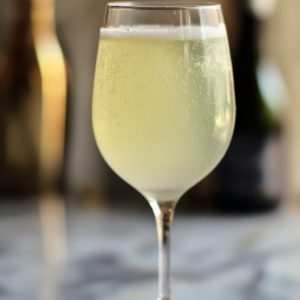The Ultimate Guide to the Hugo Spritz Recipe

Are you searching for a cocktail that embodies the light, refreshing essence of summer? Look no further than the Hugo Spritz. With its delicate elderflower notes, bubbly Prosecco, and a minty freshness, the Hugo Spritz has become a modern classic that rivals even the popular Aperol Spritz. This guide will take you through everything you need to know about the Hugo Spritz recipe, from its origins to its ingredients, variations, and the perfect pairings.
Whether you’re hosting a summer party, looking for a signature drink, or just want to impress your friends, this article has you covered. Read on to discover why the Hugo Spritz is a favorite among cocktail enthusiasts worldwide.
A Brief History of the Hugo Spritz
The Hugo Spritz was created in 2005 by Roland Gruber, a bartender from South Tyrol in Northern Italy. Designed as an alternative to the bitter Aperol Spritz, the Hugo Spritz quickly gained traction thanks to its refreshing, floral flavor profile. Its rise coincided with the growing popularity of aperitivo culture—a beloved Italian tradition of enjoying light drinks and snacks before dinner.
Over time, the cocktail transcended its local roots to become a global phenomenon, particularly in summer hotspots across Europe and beyond. Its combination of Prosecco, elderflower liqueur, soda water, and fresh mint struck the perfect balance between elegance and simplicity.
To learn more about the cultural impact of the Hugo Spritz, check out Wonder & Sundry’s aperitif guide, which dives into how this drink became synonymous with summer relaxation.
What Makes the Hugo Spritz Special?
Unlike many cocktails, the Hugo Spritz manages to be both sophisticated and easy to prepare. What sets it apart are its ingredients:
- Elderflower liqueur adds a floral sweetness that’s unique and enticing.
- Prosecco brings effervescence and a crisp, dry finish.
- Mint leaves provide a fresh aroma, enhancing the drink’s lightness.
The beauty of this cocktail is its versatility. Whether you prefer it sweeter, more citrusy, or less alcoholic, the Hugo Spritz can be tailored to suit your taste. Plus, its stunning presentation in a large wine glass, garnished with fresh mint and lime, makes it a visually appealing centerpiece for any gathering.
Ingredients for the Perfect Hugo Spritz
The Hugo Spritz requires just a handful of ingredients, but their quality can make or break the drink. Let’s dive into what you’ll need.
Essential Ingredients
- Prosecco: A dry or extra-dry Prosecco works best, as it balances the sweetness of the elderflower.
- Elderflower liqueur: Brands like St-Germain are popular, but elderflower cordial can be used for a non-alcoholic twist.
- Soda water: Adds the perfect level of fizz. Look for high-quality soda water for a clean taste.
- Fresh mint leaves: Ensure they’re fresh and aromatic for the best results.
- Lime wedge: Provides a touch of acidity to balance the drink.
Optional Ingredients
- Herbal additions: Basil or rosemary for an herbal twist.
- Fruit infusions: Fresh raspberries or sliced strawberries add a burst of color and flavor.
- Alternative sparkling wines: Cava or champagne for a luxe upgrade.
For more on ingredient selection and ratios, visit St-Germain’s official Hugo Spritz recipe, which offers expert tips.
Step-by-Step Guide: How to Make a Hugo Spritz
Creating the perfect Hugo Spritz is a simple yet satisfying process. Here’s how to do it:
Preparation
- Glassware: Use a large wine glass to showcase the cocktail’s vibrant colors and garnishes.
- Ice: Fill the glass with plenty of ice to keep the drink cold and maintain its fizz.
Ingredients and Method
- Add 1 oz of elderflower liqueur to the glass.
- Pour in 4 oz of Prosecco for that signature sparkle.
- Top with 2 oz of soda water to dilute and balance the flavors.
- Gently stir with a bar spoon to mix the ingredients.
- Garnish with fresh mint leaves and a lime wedge for an aromatic and visual flourish
Tips and Tricks for the Best Hugo Spritz
- Temperature is key: Keep your Prosecco and soda water chilled to maintain the cocktail’s crispness.
- Don’t skimp on ice: A well-chilled glass prevents the drink from becoming diluted too quickly.
- Experiment with ratios: Adjust the proportions of Prosecco, soda water, and elderflower liqueur to suit your taste.
- Freshness matters: Always use fresh mint and lime for the garnish to elevate the drink’s aroma.
Delicious Variations of the Hugo Spritz
One of the reasons the Hugo Spritz remains so popular is its adaptability. Here are some creative takes on this classic cocktail:
- Berry Hugo Spritz: Add a handful of fresh raspberries or strawberries for a fruity twist.
- Herbal Hugo: Swap mint for rosemary or basil to give the drink a savory edge.
- Citrus Hugo: Use lemon slices or orange zest instead of lime for a different citrus profile.
- Non-Alcoholic Hugo: Replace Prosecco with sparkling grape juice and elderflower liqueur with cordial.
These variations are perfect for experimenting and finding your signature version of the Hugo Spritz.
Perfect Food Pairings for the Hugo Spritz
The light, floral flavors of the Hugo Spritz pair beautifully with a variety of dishes. Here are some top recommendations:
- Appetizers:
- Bruschetta with tomato and basil.
- Marinated olives or artichokes.
- Cheese platters featuring soft cheeses like brie or goat cheese.
- Main Dishes:
- Grilled seafood, such as shrimp or scallops.
- Mediterranean salads with feta, olives, and cucumber.
- Light pasta dishes with lemon or garlic sauce.
- Desserts:
- Lemon sorbet or panna cotta with fresh berries.
- Almond biscotti for a crunchy, sweet treat.
FAQs About the Hugo Spritz
What is a Hugo Spritz made of?
The classic recipe includes Prosecco, elderflower liqueur, soda water, fresh mint, and lime.
Can I make a non-alcoholic Hugo Spritz?
Absolutely! Replace Prosecco with sparkling grape juice and use elderflower cordial instead of liqueur.
What’s the difference between a Hugo Spritz and an Aperol Spritz?
While the Aperol Spritz features bitter orange notes, the Hugo Spritz is floral and sweet, making it a milder alternative.
What type of Prosecco works best for a Hugo Spritz?
A dry or extra-dry Prosecco is ideal, as it balances the sweetness of the elderflower.
Can I experiment with other sparkling wines?
Yes! Cava, champagne, or even sparkling cider can work as alternatives to Prosecco.
The Cultural Impact of the Hugo Spritz
In recent years, the Hugo Spritz has gained a cult following on social media. From Instagram-worthy photos of its vibrant presentation to TikTok videos showcasing creative variations, this cocktail has become a symbol of modern summer indulgence.
Its role in aperitivo culture—a ritual of enjoying light drinks and snacks—further solidifies its place as a staple in European cafes and bars. Whether you’re in Milan, Paris, or New York, ordering a Hugo Spritz signals your appreciation for refined, yet unpretentious, cocktails.
Conclusion
The Hugo Spritz is more than just a drink—it’s a celebration of summer, a nod to tradition, and an invitation to relax and savor the moment. With its delicate blend of elderflower, Prosecco, and mint, this cocktail is perfect for any occasion, whether you’re lounging by the pool or hosting a dinner party.
Now that you’ve learned the history, mastered the recipe, and explored creative variations, it’s time to craft your own Hugo Spritz. Experiment with flavors, pair it with your favorite dishes, and enjoy the floral, bubbly delight that has captivated cocktail enthusiasts around the world. Cheers to your next summer sip!

